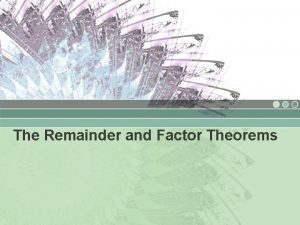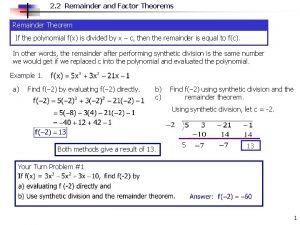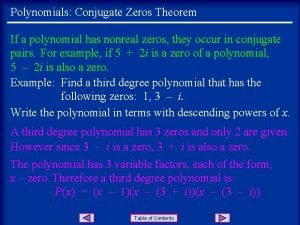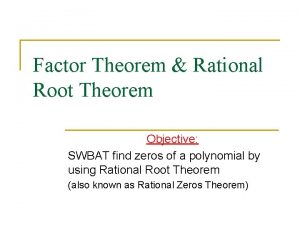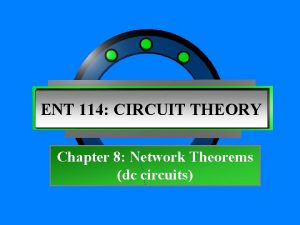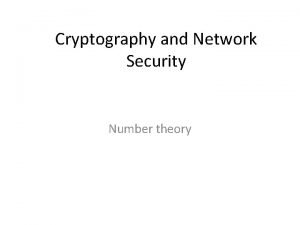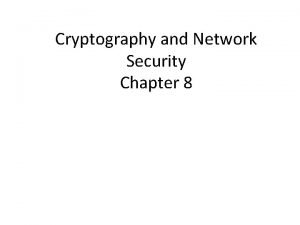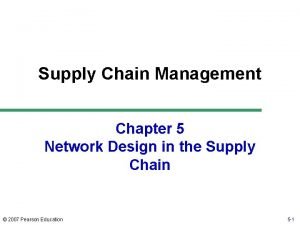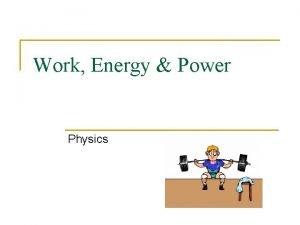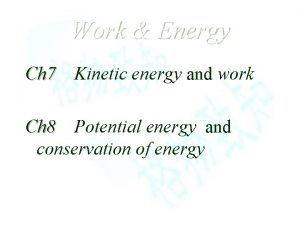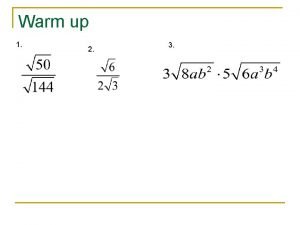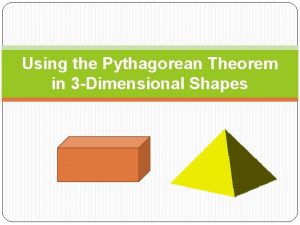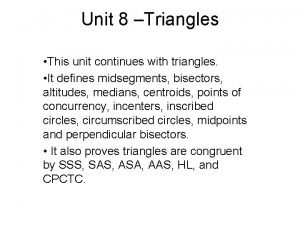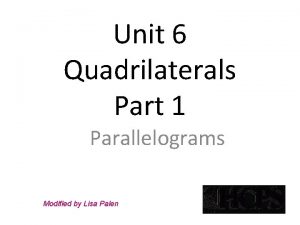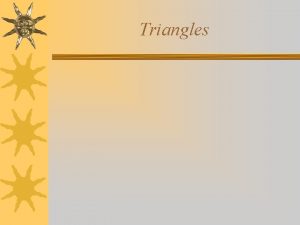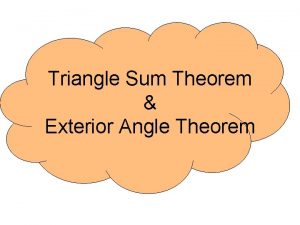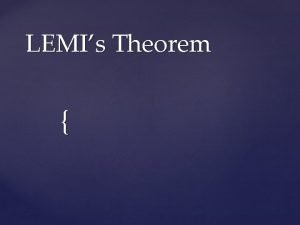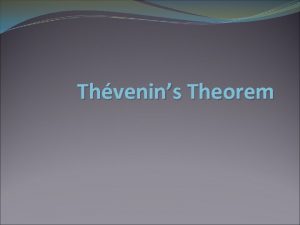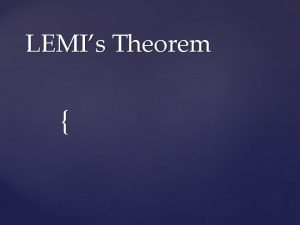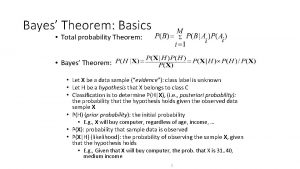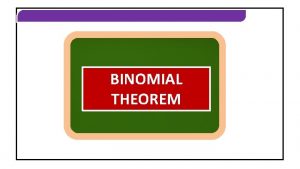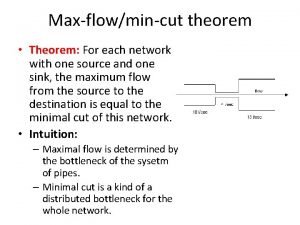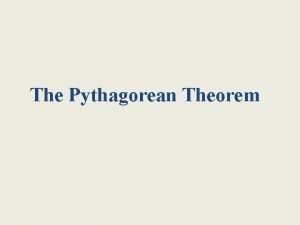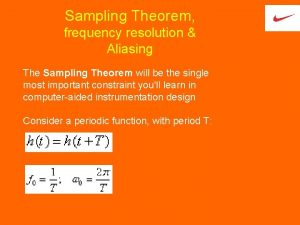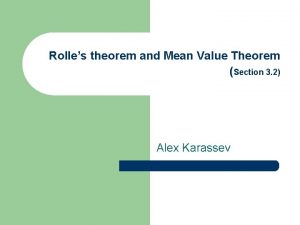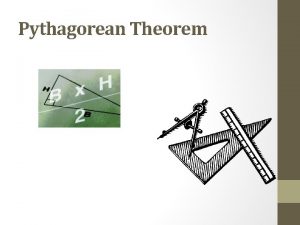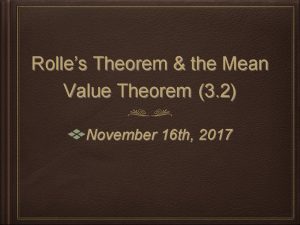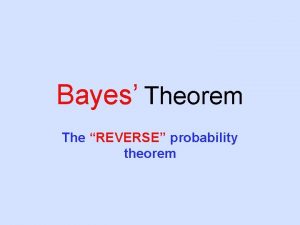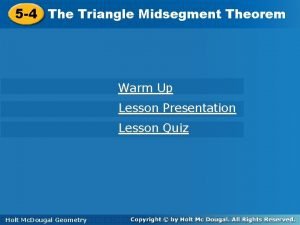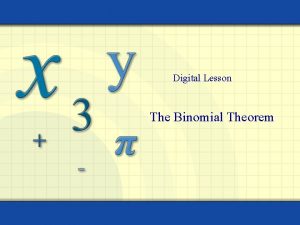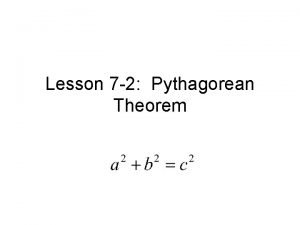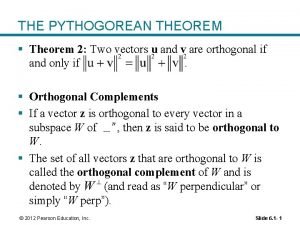CHAPTER 3 NETWORK THEOREM NETWORK THEOREM n n
















































- Slides: 48

CHAPTER 3 NETWORK THEOREM

NETWORK THEOREM n n n Superposition Theorem Source Transformation Thevenin & Norton Equivalent 2

SUPERPOSITION THEOREM 3

Principle If a circuit has two or more independent sources, the voltage across or current through an element in a linear circuit, is the algebraic sum of voltages across or current through that element due to each independent source acting alone. 4

Steps to apply superposition principle n Turn off all independent sources except one sources. n n n For voltage source replace by short circuit For current source replace by open circuit. Find voltage or current due to that active source using any technique. Repeat the procedure for each of the other source Find total contribution by adding algebraically all the contribution due to the independent source 5

Practice Problem 10. 5 Find current in the circuit using the superposition theorem 6

Solution Let Io = Io’ + Io” where Io’ and Io” are due to voltage source and current source respectively. For Io’ consider circuit beside where the current source is open circuit For mesh 1 …(1) For mesh 2 …(2) 7

Solution Substitute equation (1) into equation (2) 8

Solution For Io” consider circuit beside where the voltage source is short circuit Let 9

Solution Therefore 10

Practice Problem 10. 6 Calculate Vo in the circuit using superposition theorem 11

Solution Let vo = vo’ + vo” where vo’ is due to the voltage source and vo” is due to the current source. For vo’ we remove current source which is now open circuit Transfer the circuit to frequency domain ( = 5) By voltage division 12

Solution For vo” we remove voltage source and replace with short circuit Transfer the circuit to frequency domain ( = 10) By current division Let 13

Solution Thus Therefore 14

SOURCE TRANSFORMATION 15

Source Transformation Source transformation in the frequency domain involves transforming a voltage source in series with an impedance to a current source in parallel with an impedance, or vice versa. 16

Example 10. 7 Calculate Vx in the circuit by using source transformation 17

Solution If we transform the voltage source to a current source, we obtain the circuit as shown. The parallel combination of 5 resistance and (3+j 4) impedance gives a new equivalent impedance Z 1 18

Solution Convert the current source to a voltage source yields the circuit as below We then could solve for VX by using voltage division 19

Practice Problem 10. 7 Find Io in the circuit by using the concept of source transformation 20

Solution If we transform the current source to a voltage source, we obtain the circuit as shown. 21

Solution We transform the voltage source to a current source as shown below Note that Let Then 22

Solution By current division 23

THEVENIN & NORTON EQUIVALENT CIRCUIT 24

Equivalent Circuit Thevenin Equivalent Circuit Norton Equivalent Circuit 25

Relationship Keep in mind that the two equivalent circuit are related as and Vth = VOC = open circuit voltage IN = ISC = short circuit current 26

Steps to determine equivalent circuit Zth or ZN Equivalent impedance looking from the terminals when the independence sources are turn off. For voltage source replace by short circuit and current source replace by open circuit. Vth Voltage across terminals when the terminals is open circuit IN Current through the terminals when the terminals is short circuit Note When there is dependent source or sources with difference frequencies, the step to find the equivalent is not straight forward. 27

Practice Problem 10. 8 Find the Thevenin equivalent at terminals a-b of the circuit 28

Solution To find Zth, set voltage source to zero 29

Solution To find Vth, open circuit at terminals a-b 30

Example 10. 9 Find Thevenin equivalent of the circuit as seen from terminals a-b 31

Solution To find Vth, we apply KCL at node 1 2 Applying KVL to the loop on the right-hand side 1 Thus the Thevenin voltage is 4 Replace eq. 2 into eq. 1 3 32

Solution To find Zth, we remove the independent source. Due to the presence of the dependent current source, connect 3 A current source to terminals a-b At the node apply KCL Applying KVL to the outer loop Thevenin impedance is 33

Practice Problem 10. 9 Determine the Thevenin equivalent of the circuit as seen from the terminals a-b 34

Solution To find Vth, consider circuit beside At node 1, 1 At node 2, but Thus node 2 become 2 35

Solution Put equation (1) and (2) in matrix form Find determinant for the matrix (Cramer’s Rule) 36

Solution To find Zth, we remove the independent source and insert 1 V voltage source between terminals a-b At node a, But And So 37

Solution Therefore 38

Example 10. 10 Obtain current Io by using Norton’s Theorem 39

Solution To find ZN, i) Short circuit voltage source ii) Open circuit current source As a result, the (8 -j 2) and (10+j 4) impedances are short circuit. 40

Solution To find IN, i) Short circuit terminal a-b ii) Apply mesh analysis Notice that mesh 2 and 3 form a supermesh. Mesh 1 …(1) Supermesh …(2) 41

Solution At node a, due to the current source between mesh 2 and 3 …(3) Adding equation (1) and (2) gives From equation (3) The Norton current is 42

Solution By using Norton’s equivalent circuit along with the impedance at terminal a-b, we could solve for Io. By using current division 43

Practice Problem 10. 10 Determine the Norton equivalent circuit as seen from terminal a-b. Use the equivalent to find Io 44

Solution To find ZN, i) Short circuit voltage source ii) Open circuit source ZN = = = 45

Solution To find IN, i) Short circuit terminal a-b ii) Solve for IN using mesh analysis 46

Solution Supermesh …(1) …(2) Mesh 3 …(3) Solving for IN 47

Solution Using Norton equivalent, we could find Io 48
 Stokes theorem proof
Stokes theorem proof What is remainder theorem
What is remainder theorem Synthetic division and the remainder theorem
Synthetic division and the remainder theorem Remainder theorem
Remainder theorem Conjugate zeros theorem
Conjugate zeros theorem Rational roots theorem
Rational roots theorem Linear factors theorem and conjugate zeros theorem
Linear factors theorem and conjugate zeros theorem Devider
Devider Source
Source Euler's theorem in cryptography
Euler's theorem in cryptography Euler's theorem in cryptography and network security
Euler's theorem in cryptography and network security Datagram vs virtual circuit
Datagram vs virtual circuit Network topology in computer network
Network topology in computer network Features of peer to peer network and client server network
Features of peer to peer network and client server network Network systems design using network processors
Network systems design using network processors Network centric computing
Network centric computing Advantage and disadvantages of packet switching
Advantage and disadvantages of packet switching Facility role in network design
Facility role in network design Chapter 3 network protocols and communications
Chapter 3 network protocols and communications The red tent summary chapter by chapter
The red tent summary chapter by chapter The great gatsby chapter 8 and 9 summary
The great gatsby chapter 8 and 9 summary Chapter 10 chemical reactions
Chapter 10 chemical reactions Chapter 11 stoichiometry answer key
Chapter 11 stoichiometry answer key Chapter 9 chemical reactions study guide
Chapter 9 chemical reactions study guide Means and extremes of proportions
Means and extremes of proportions Chapter 6: career readiness
Chapter 6: career readiness 7 ionic and metallic bonding
7 ionic and metallic bonding Chapter 9 surface water chapter assessment answer key
Chapter 9 surface water chapter assessment answer key Chapter 2 representing motion chapter assessment
Chapter 2 representing motion chapter assessment Chemistry central science 14th edition
Chemistry central science 14th edition Chapter 7 ionic and metallic bonding assessment answer key
Chapter 7 ionic and metallic bonding assessment answer key Population ecology section 1 population dynamics
Population ecology section 1 population dynamics Chapter 2 standardized test practice answers
Chapter 2 standardized test practice answers Background of the book of philippians
Background of the book of philippians Properties of ionic compounds
Properties of ionic compounds Chapter 7 chapter assessment ionic compounds and metals
Chapter 7 chapter assessment ionic compounds and metals Tribromine octoxide formula
Tribromine octoxide formula How is mechanical energy formed
How is mechanical energy formed Potential energy and work
Potential energy and work Work energy theorem
Work energy theorem Pythagorean theorem warm up
Pythagorean theorem warm up Explain varignon's theorem
Explain varignon's theorem Pythagorean theorem for 3d shapes
Pythagorean theorem for 3d shapes Folk theorem
Folk theorem Side-splitter theorem
Side-splitter theorem Parallelogram proof
Parallelogram proof Quadrilateral inequality theorem
Quadrilateral inequality theorem Sum of a triangle
Sum of a triangle Triangle sum theorem
Triangle sum theorem

